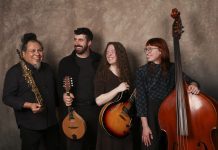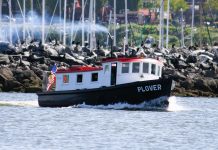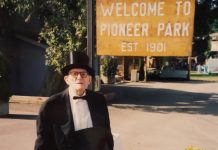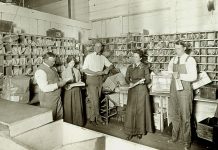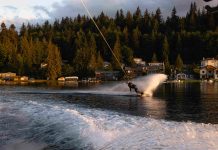If you like to see history in action, make plans to visit Skagit Regional Airport in Burlington and watch pilots exercise the Heritage Flight Museum’s fleet of vintage military aircraft.
Heritage Flights Fly Days are scheduled from noon to 4:00 p.m. on the third Saturday of the month, April through October – weather permitting.
Between Fly Days, Heritage Flight has about a dozen historic aircraft on display in its hangars, said Kate Simmons, director of programs and administration. Sitting outside on the tarmac are a recently acquired Soviet-era MiG-21, a restored U.S. Air Force F-89 Scorpion and the world’s largest piston engine: Pratt and Whitney’s R-4360, a 28-cylinder, 3,500-horsepower, radial monstrosity that weighs nearly 2 tons.
Historic Flight’s collection of flyable aircraft from the World War II, Korea and Vietnam eras includes a growing collection of memorabilia from the same time frame. Look for military-spec Jeeps, bombsite instruments, uniforms, Allison V-12 engines, and an Apollo mission capsule.
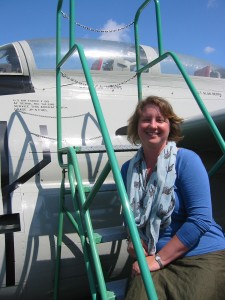
Those who remember the opening scene of the TV show “M*A*S*H*” will recognize the rescue chopper that flew injured soldiers to the field hospital.
“We’ve got all sorts of fun stuff,” said mechanic Syd Slade.
After Simmons shows off the MiG and the Scorpion, Slade is inside topping off the engine oil in a Stearman PT-13 biplane. Built by Boeing starting in 1936, this was a training aircraft for new military pilots as World War II’s storm clouds grew.
Slade then leads the way across the hanger to The Pearl, an Interstate Cadet. To the untrained eye, it resembles a modest Piper Cub: It’s small, with the wing over the fuselage and open wheels below.
Slade explains that this plane was actually in flight over Pearl Harbor and survived during Japan’s attack on the US Navy base in Hawaii on December 7, 1941.
Cornelia Fort, a pioneering woman in aviation, launched the Cadet that day to teach a flying lesson over Pearl Harbor. She took control to avoid being rammed by an attacking Japanese aircraft, and then avoided subsequent air-to-air and air-to-ground Japanese strafing passes on a day that claimed 2,335 US servicemen and 68 civilians. The Cadet ended up with several bullet holes in it.
In 1942, Fort joined the Army Air Force’s new Women’s Auxiliary Ferry Service but died in 1943 during a mid-flight collision on a WAFS ferrying flight. She was America’s first female aviation casualty of WWII.
Simmons said the museum started Fly Days soon after it opened to the public in 2004 at Bellingham International Airport as a way to gain publicity and keep the vintage craft airworthy.
Founded in 1996 by Apollo 8 astronaut Maj. Gen. William Anders, the Heritage Flight Museum is a non-profit organization dedicated to the preservation and flying of historic military aircraft. The museum moved to Skagit Regional Airport in 2013 and celebrated its grand opening on April 26, 2014.

Simmons said Heritage Flight owns most of its planes, unlike many other museums where planes are often on loan from collections.
What further separates Heritage Flight from other aviation museums is intimacy. No velvet ropes or rails keep visitors from touching the displays, so they risk stained shirts and greasy hands from the inevitable engine oil leak. That’s fine as far as the museum is concerned.
On Fly Days, the museum keeps visitors at a safe distance, but not so far away that they can’t get a whiff of exhaust fumes or feel the blow from prop wash. Other warbirds from around the region often come to Burlington for Heritage Flight’s Fly Days.
Simmons said Fly Days typically draw at least 200 guests, but Props and Ponies will attract at least 1,000 people. The event began in August 2013 as Heritage Flight’s first event at its new Burlington home. As for the name, it comes from the museum’s iconic P-51 Mustang fighter sharing space with dozens of Ford’s equally iconic pony car, the Mustang.
Heritage Flight Museum’s attendance has been steadily growing since the move from Bellingham, Simmons said.
“We love it here,” she said, citing the proximity of the runway in particular.
Bellingham’s hangar was smaller and the runway was a half-mile away, so it was hard for Fly Day visitors to see planes take off, she said.
When Fly Days start at noon, Heritage Flight’s pilots try to stage an array of flights, with one demonstration every hour. It might be a single-ship fighter or a formation of T-6 trainers, but if the weather allows, pilots will get something from the museum’s fleet into the sky for a trip back in aviation history.

Fly Days are scheduled for:
- May 21
- June 18
- July 16
- August 20 (Props and Ponies)
- September 17
- October 15
Heritage Flight Museum is located at Skagit Regional Airport, 15053 Crosswind Drive, Burlington. From Interstate 5, exit at Highway 20 and head west. West of Burlington, turn right on Higgins Airport Way and look for the signs pointing to the museum about one mile north of Highway 20.
Museum hours are 9:00 a.m. to 3:00 p.m. Tuesday through Saturday. Regular admission is $8 for adults, $5 for children.




